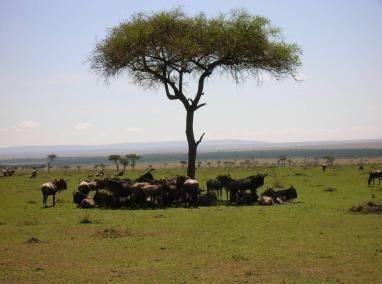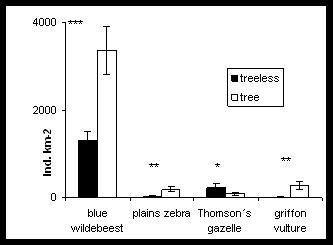Use of solitary trees by blue wildebeest, plains zebra, Thomson´s gazelle and griffon vulture.
Per Eriksson
Solitary trees create structural variation in the otherwise monotonous grasslands of Maasai Mara. The solitary trees are diminishing in the area, but are they important?

Background
Animal distribution is caused by several factors, including food and water, but also shelter from the sun can influence1. The main shade providing structure in the study area are solitary trees, foremost desert date (Balanites aegyptiaca) and shepherd´s tree (Boscia Albitrunca), but the solitary trees are diminishing in Maasai Mara. Solitary trees provide food, nest sites and shade, and can be important for animal diversity2. Their importance for the wildlife is not really known and I wanted to study this. I did it by investigating if solitary trees influence the distribution and behaviour of blue wildebeest (Connochaetes taurinus), plains zebra (Equus burchelli), Thomson´s gazelle (Gazella thomsonii) and griffon vultures (Gyps rueppellii & Gyps africanus). Two field trials were done in Maasai Mara August-September 2006; one looking at areas of 0.3 km2 with zero to 40 trees (transect study) and one focusing at the trees in these areas (photo study). Number of solitary trees and number of individuals per animal species were examined to see if they were correlated. At the tree-level, number of animals close to the tree was compared with an adjacent treeless area with the same radius, to see if the two small areas differed.
Findings

The number of trees did not influence the distribution of wildebeests, neither total nor during the hot hours. Number of zebras and Thomson´s gazelles were positively correlated with the number of trees on burned transects, both total and during the hot hours. During the hot hours the correlation seemed to be stronger. The number of griffon vultures was positively correlated with number of trees. The correlation coefficients in the transect study ranged between 0.24 - 0.35. More vultures perched in trees than sat on the ground.
The occurrence of species differed between tree and treeless control areas. Wildebeests, zebras and Griffon vultures preferred tree area, while Thomson´s gazelles preferred the treeless control area (figure 2). Wildebeests were standing and lying more in the tree areas compared to control areas. Grazing occurred more in the controls. There was a strong tendency of increased moving in the control.
Discussion
There are many factors influencing animal distribution and this is seen in the transect study where the correlation coefficient were below 0.4. This means that the animal distribution could maximum, only be explained to 40 % by the number of trees. There was also a potential bias in the transect study since the presence of trees and animals may be caused by a third factor, e.g. soil type. This potential bias was excluded in the photo study were paired adjacent areas were compared; the only difference between the areas was the presence of a solitary tree. Solitary trees were important for wildebeest , zebra and Griffon vulture. The conclusions for Thomson´s gazelle remain unclear due to the different results in the two studies. These findings strengthen the importance of solitary trees for the ecosystem but also for animal welfare.
References
Responsible for this page:
Director of undergraduate studies Biology
Last updated:
05/15/06
